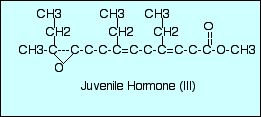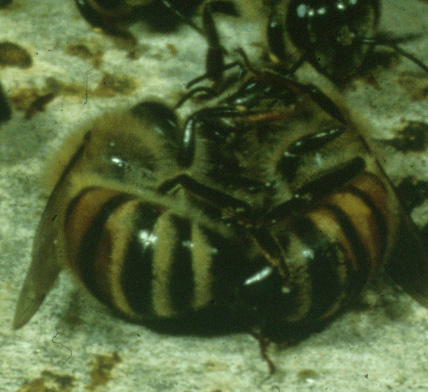
Juvenile Hormone
Juvenile hormone (JH), produced by the corpora allata, regulates two important processes in insects. The first is development; as an insect develops, the degree juvenility of the next stage is determined by the amount of JH in the blood; the lower the JH, the more adult the next stage. Experimental removal of the corpora allata results in premature development of adult characteristics. JH occurs in several forms, the most common is JHIII, which is shown here.

The other function of JH is, in many insects, to regulate the production of eggs in the female's ovaries. Because mating behavior is often synchronized with the ovarian cycle, it makes sense for mating behavior and pheromone production to be linked with JH. In some insects, including species of cockroach this is exactly the case.
In other species the role of JH has evolved one step further, so that the linkage with ovarian activity is lost. In the most intensively studied species, the honey bee, many scientists think JH regulates the behavioral activities of workers through their life. In burying beetles JH has also apparently lost its role in controlling reproduction, instead regulating social behavior.
|
Aggressiveness of guard bees is correlated with their blood JH levels, for example. Even though guards have high JH levels, their ovaries are relatively undeveloped. In this picture a guard bee has attacked a bee from another colony, preventing her from entering the guard's nest. JH titers in worker honey bees progressively increase through the first 15 or so days of the worker's life. During this period workers perform tasks inside the hive, such as nursing larvae, constructing comb, and cleaning cells. JH titers peak around day 15; workers this age guard, remove dead bees from the colony, and fan at the colony entrance to cool the nest. Older workers forage for pollen and nectar This behavior prevents robbing of honey from the nest by bees from other colonies. It is not an easy trick for the guards to tell which incoming bees to attack and which to not. They do this by smelling odors on the surface of the incoming bees; the bees that do not smell like nestmates are attacked. Nestmate recognition is similar to kin recognition, and is expressed by most eusocial insects--termites, ants, bees and wasps.
|
 |
Beshers SN, Fewell JH 2001 Models of division of labor in social insects Ann. Rev. Entomol. 46: 413-440
Maleszka R, Helliwell P 2001 Effect of juvenile hormone on short-term olfactory
memory in young honeybees (Apis mellifera)
Hormones and Behavior 40 (3): 403-408
Pearce AN, Huang ZY, Breed MD 2001 Juvenile hormone and aggression in honey
bees
J Insect Physiol. 47 (11): 1243-1247
Scott MP, Trumbo ST, Neese PA, et al. 2001 Changes in biosynthesis and degradation of juvenile hormone during breeding by burying beetles: a reproductive or social role? J Insect Physiol. 47 (3): 295-302
Teal PEA, Gomez-Simuta Y, Proveaux AT 2000 Mating experience and juvenile hormone enhance sexual signaling and mating in male Caribbean fruit flies Proc. Natl. Acad. Sci. USA 97 (7): 3708-3712
page 2-*
copyright ©2002 Michael D. Breed, all rights reserved